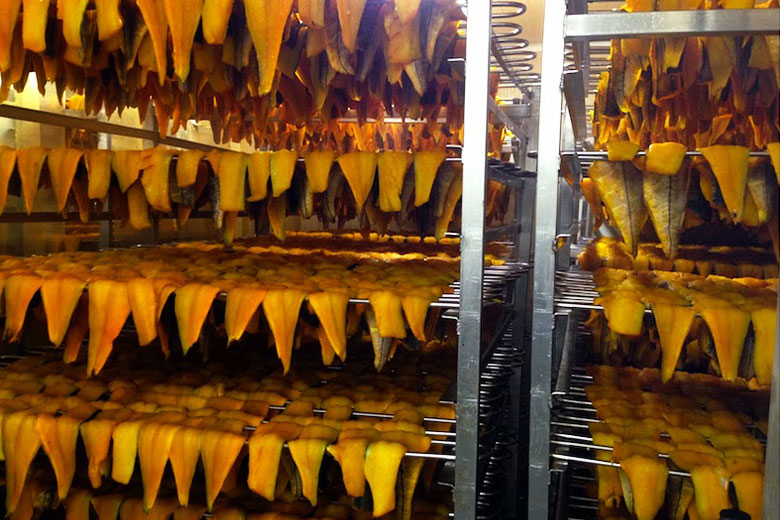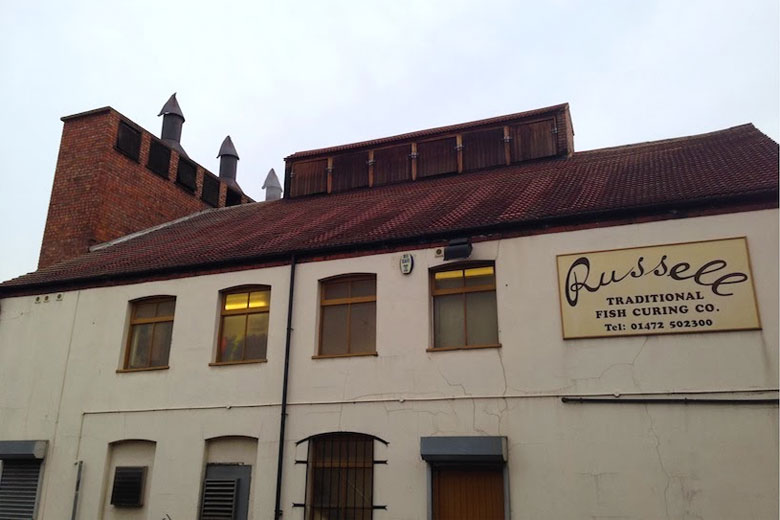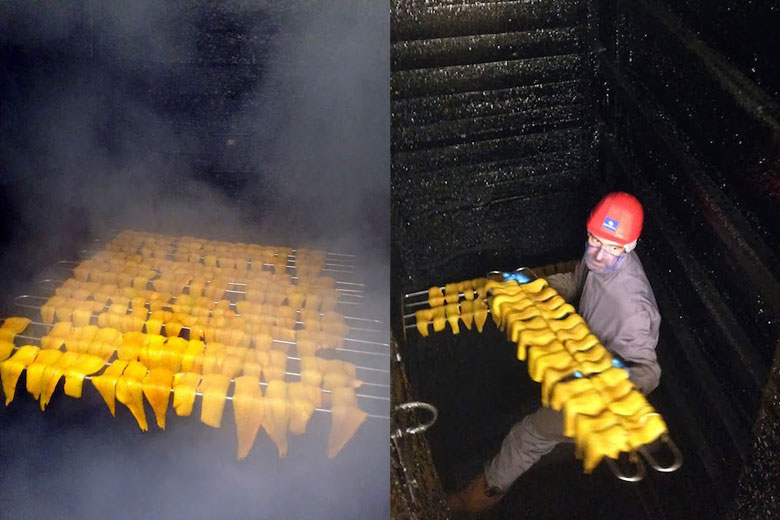Time honoured
Russell’s in Grimsby is one of the last remaining traditional fish-curing smokehouses in the UK. Now a heritage site, it still smokes haddock the same way that it’s always done, in chimneys now black with a century’s worth of glorious tar. Dominic Franks pays a visit.

It was a very early October morning when I left the comfort of home and set off in twilight to visit the hardworking men at Russell’s Smokehouse in Grimsby. And as the sun began its slow stretch up from its slumber and the sky began to lighten, I realised that I was as giddy as a schoolboy at the prospect of the visit.
You see, I simply love smoked fish. It was always a staple in our house when I was growing up. Whether it was smoked haddock in my mum’s incredible creamy fish pie or smoked salmon in my grandma Jennie’s fishcakes, our whole family loved it. I guess it was the fact that mum grew up on the other side of the Humber in Hull that established her love of fish – and my grandparents came from an age when fish was smoked to preserve the fresh catch, ensuring that it could last into leaner times. So it was natural that they would all pass their fondness for smoky goodness on to me.
Russell’s Smokehouse has been in business for nearly 100 years and is now one of only a handful of traditional fish-curing smokehouses in the UK. It’s part of a small group of traditional Grimsby smokehouses whose products are protected by PGI (Protected Geographical Index: the same status that protects Melton Mowbray pork pies, for example). Now only fish produced in Grimsby using the traditional method can be called Grimsby Traditional Smoked Fish – a hard-won victory that came after years of EU campaigning, which started back in the 1990s.
Russell’s has a strong family tradition too. Joe Tummey started working there in 1946 and didn’t retire until he was 76 years old. His son Peter took over the business in 1982, and although it was bought by Seachill in 1999, there is still a family connection, as Joe’s grandson Dave is now the manager, having started work there at the tender age of 13.

I started my morning at Grimsby Fish Market, where I was met by David Markham, a representative from Seachill. David wanted me to see the complete cycle of the fish-smoking process, and other than taking a trip on a North Sea fishing trawler, the fish market is the best place to start. It’s certainly not the bustling place it used to be, but it still holds a very important place within the food chain with representatives from all the major fish companies buying at the auction (more on this in a future post).
It was a frenetic experience to say the least and quite bizarre to be greeted by the ugly smiles of the cod so early in the day – but I’m glad I saw how it all works. I was also fortunate enough to see some of the fishing boats in the dock, moored up for the winter.

Now we had the fish it was time to visit the smokehouse itself. Just a short drive away, we could see the chimneys of the smokehouse hard at work and, more importantly, we could smell them too. I love the smell of the smoking process: it has a textured richness that is unmistakable. It’s not an intense aroma; rather it’s deep and woody and, yes, a little fishy. The building itself is actually listed as a heritage site. The inside is now clad in hygienically reinforced walls, but at one time it would have been beautifully lined with wood. Fortunately the chimneys themselves are still the original stacks, which becomes clear when we peer inside to see the walls thick with a century’s worth of glorious black tar.
The curing process is relatively simple. The fish arrives from the market filleted and is first brined in iced saltwater for a few minutes before being draped over the “horses”, which are simple metal frames. Some of the fish is dyed using a vegetable-based yellow dye, a technique originally used to mask any discolouration. The quality of the fish has since improved so this process is no longer necessary, but some of the fish is still dyed for the sake of tradition – not least because many people still expect to see the yellow fish.

Early each morning, a pit at the base of the chimneys is filled with sawdust and lit. The fire is matured slowly to create more smoke and less heat, and then the fish are stacked up to 17 layers high inside the chimney. This job is still done by hand with the men harnessed for security as they straddle the brackets with their feet. The fish is then smoked slowly overnight for up to 15 hours and is then ready to be chilled and packed for us all to enjoy.
It was an incredible day and wonderful to meet people so passionate about their contribution to our food enjoyment. And while many of the other smokehouses in Grimsby have now sadly closed, the future of Russell’s looks safe in Seachill’s hands. Of course, I was sent away with a freezer-load of beautiful fish and have been pretty much working my way through it creating recipes, including this one for smoked haddock risotto with cavolo nero. Eat and enjoy!

Dominic Franks is a cook and food writer. He has his own blog called Belleau Kitchen – www.belleaukitchen.com – and writes regularly for Lincolnshire Life Magazine. He also often appears on BBC Radio Lincolnshire and Humberside. In his “day job”, he runs a creative events company called The Persuaders: www.thepersuaders.co.uk.





